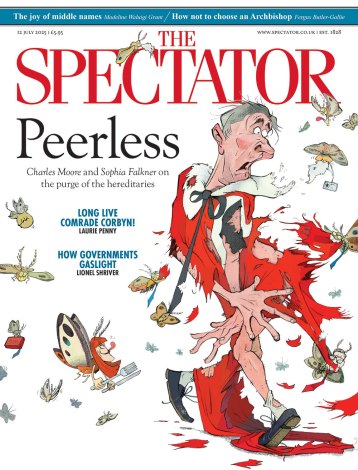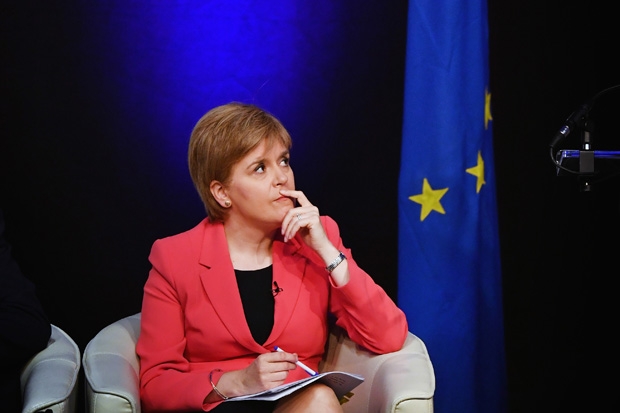This time two years ago, the United Kingdom stood on the brink of dissolution. The referendum on Scottish independence hung in the balance and momentum was with the nationalists. The optimism and energy of Alex Salmond’s campaign stood in admirable contrast to the shrill hysteria of Project Fear, the name given to a unionist campaign that churned out ever-less-credible warnings about what would happen after separation. The union was saved, but 45 per cent of Scots had voted to leave it. So the referendum had not closed the question, but left it wide open.
At the time, the North Sea oil sector was still in fairly good health. In the SNP’s economic manifesto for independence, it gave estimates of up to £7.9 billion a year for oil revenues. Then the oil price crashed — and oil revenues are now 99 per cent lower, at £60 million. This is no freak: America has mastered fracking and doesn’t need to import so much oil now, pushing the price of a barrel down from $110 to $45. This hasn’t hurt the UK economy because the stimulus from cheaper fuel generally balances out lower North Sea receipts. A country of 65 million can absorb such shocks. A separate Scotland simply could not.

Had the SNP achieved its stated ambition of ‘independence day’ in the spring of 2016, what would it be doing now? We don’t have to imagine. This week, the Scottish government published figures for its national finances. They show that the Scottish government spends £127 for every £100 it raises in tax — a ratio unequalled anywhere else in the developed world. It can do this because so much extra money is sent up from England. For every £100 spent per English head, £120 is spent on a Scottish one.
Greece, Italy, Albania — no country, no matter how economically distressed, has such a mismatch between state spending and tax collected. Scotland’s deficit — at 10.1 per cent of GDP — is now twice as big as the next-worst country (Japan). No independent country could afford to run a deficit of Scottish magnitude: to borrow on world markets, you need a semblance of fiscal respectability. Even to join the European Union, Scotland’s deficit would need to be below 3 per cent. So an independent Scotland would right now be facing a choice: state spending down by 15 per cent, taxes up by 19 per cent, or a combination of the two.
The cuts are certainly doable. The Scottish government machine is vast, and at times the whole enterprise looks like an attempt to recreate East Germany. Nicola Sturgeon could certainly propose a rapid slimming-down of government, and say that this is a price worth paying for secession. But as her own government figures now make clear, she could not pretend that an independent Scotland could sustain current levels of largesse. She can forget about free university tuition and free personal care for the elderly.
The SNP’s case for separation has always rested on three pillars: that the black gold in the North Sea would transform the economy, that Scotland’s priorities are irreconcilably different from those of England, and that Scottish government always means better government. Each of these three pillars has now collapsed. The North Sea dream has ended: jobs and expertise have already shifted to the Caspian Sea and the Gulf of Mexico. As to the second pillar, the British Social Attitudes survey, the largest of its kind, shows Scots growing ever closer to the English in their outlook to politics, culture and society.
And better government? The SNP has now had nine years to prove its theory that decisions taken by officials in Edinburgh are better when it comes to schools, hospitals, transport and the environment. But even Nicola Sturgeon cannot claim that the NHS is better in Scotland than in England. Or that Scotland’s state education system is more progressive than England’s. On the contrary, a poor Scottish teenager is now half as likely to get into university as a poor English one. The merging of regional police services into Police Scotland has been a disaster.
Now and again it is argued that the EU referendum has made Scotland more likely to vote for independence. While it’s true that only two in five Scots supported Brexit, this has hardly transformed the desire for independence. The basic economic reality is stark, and undeniable: an independent Scotland would be a Scotland embarking on the most ambitious austerity programme attempted by any western country in peacetime. There may well be a case for this. But as of this week, the SNP can no longer pretend that separation and sado-austerity would not come hand in hand.
And the case for the Union? North Sea oil revenue has all but vanished — but there has been no national hammerblow as a result. Instead, more Scots are in work than ever before. Scottish pensioner poverty is lower than ever before. Scottish household wealth is higher than ever before.
By being plugged into the larger economic network of the United Kingdom, Scots have not just been shielded from the oil slump, but have been able to achieve more than ever. The pooling of resources works. Scotland and England are now, more than ever,better together.






Comments